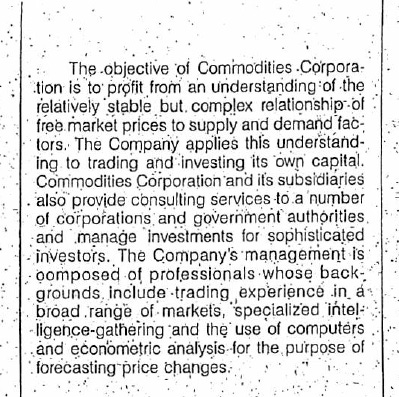Commodities Corporation: Traders, Innovators, and Making a Virtue out of Necessity
"I have known many great traders and 99% of the time, the market is bigger than anybody. It goes where it wants to go. There are exceptions, but they don’t last too long." Michael Marcus
Hello everyone,
A couple of weeks ago, I had a chance to interview Michael Mauboussin (the full conversation will be available at Compound soon). I asked him about his tweets about Druckenmiller and he out the paradox of position sizing:
“Here we have George Soros and Stanley Druckenmiller, two legendary investors who say that this is the main thing that drives their returns and results over a long period of time. Whereas we look at the real world, we find that most people don't create a lot of value from sizing and it's all security selection. The question is can we bring those things together to some degree?”
His comment hit on a broader point: it’s easy to ascribe the most value to tasks that receive the most attention or seem the most interesting. Many books have been written about how Buffett picks stocks. But what is more interesting is how he created conditions of longevity when he discarded the hedge fund structure in favor of Berkshire Hathaway’s permanent capital or how he evolved as an investor by cultivating new friends or mentors. There is too much focus on specific actions (in his case investments) compared to the design choices he made in business and life.
Similarly, a book outlining some of Renaissance Technologies' mysterious algorithms might sell very well even though their publication would presumably render them useless. After learning about Jim Simons’s five principles, I dipped back into his biography, The Man Who Solved the Market. I was struck by how much his success was based on creating conditions that ultimately led to success. Simons courted talent and provided space and encouragement to test and refine their ideas. While he kept building the system behind Renaissance, individual researchers and traders churned. “I’m doing all the trading, and he’s just dealing with the investors,” one early partner complained in a classic case of misunderstanding what was driving long-term value.
When one of his researchers became obsessed with collecting more granular historical pricing data, Simons was happy to indulge this curiosity even though it was effectively R&D without a clearly defined payoff. It was an investment in building a system rather than an individual strategy.
“Straus and his colleagues created and discovered additional historical pricing data, helping Ax develop new predictive models relying on Carmona’s suggestions. Some of the weekly stock-trading data they’d later find went back as far as the 1800s, reliable information almost no one else had access to. At the time, the team couldn’t do much with the data, but the ability to search history to see how markets reacted to unusual events would later help Simons’s team build models to profit from market collapses and other unexpected events, helping the firm trounce markets during those periods.” The Man Who Solved the Market
Simons created a campus for the best quants he could find. This reflected his second principle: “Surround yourself with the smartest and best people you possibly can. Let them do their thing. Don’t sit on top of them. If they’re smarter than you, all the better.”
He wasn’t the first to build a firm around quantitative research with a culture modeled to be distinct from mainstream Wall Street. In 1969, a kind of proto-Renaissance Technologies opened in Princeton, NJ.
Helmut Weymar wrote his PhD dissertation at MIT about a method for anticipating the price of cocoa based on an analysis of fundamental data affecting supply and demand (such as economic growth and weather conditions). After a stint at food conglomerate Nabisco, where he traded cocoa based on his model, he left to set up his own firm: Commodities Corporation.
Weymar assembled a group of specialists in different commodities. He believed the combination of sector expertise, deep fundamental research, and use of new computer technology would provide the firm with an edge. Like in the early days of Renaissance, computers were not yet advanced enough for complex and fully-automated trading systems. They existed to support human traders.
In its brochure the firm described its objective as profiting “from an understanding of the relatively stable but complex relationship of prices to supply and demand factors” through “specialized intelligence gathering” (e.g. the firm hired people who traveled emerging markets surveying conditions on the ground) and “the use of computers and econometric analysis.”
It was an auspicious time to start a commodities-focused firm, right at the beginning of a new bull market.



